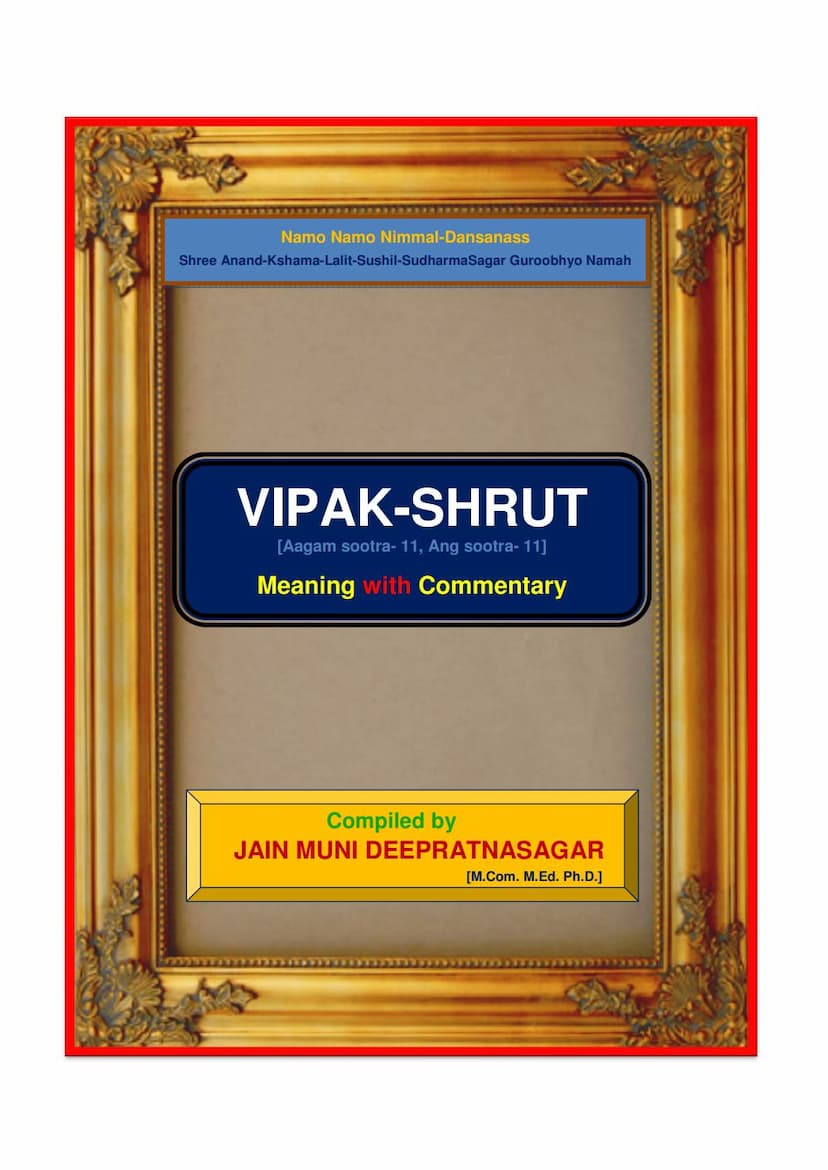Agam 11 Ang 11 Vipak Sutra English Translation
Added to library: September 1, 2025

Summary
This document is an English translation and commentary of the Jain Agam Sutra, Vipak Shrut (also known as Vipak Sutra), which is the eleventh Anga Sutra. It was compiled by Muni Deepratnasagar and published by Deepratnasagar. The translation is presented as a "Net Publication" and aims to make Jain Agam literature accessible in English for a wider audience.
Key Aspects of the Vipak Shrut:
-
Structure: The Vipak Shrut is divided into two main parts, called Shrutskandhs:
- Shrutskandh-1: Duhkha-vipaak (Fruits of Bad Karmas): This part focuses on the severe consequences of negative actions. It consists of ten chapters, each detailing the suffering experienced in this life and future rebirths due to sinful deeds.
- Shrutskandh-2: Sukha-vipaak (Fruits of Good Karmas): This part describes the positive outcomes and happiness gained from virtuous actions, particularly charity. It also consists of ten chapters.
-
Content and Purpose: The primary purpose of the Vipak Shrut is to illustrate the Jain doctrine of karma, emphasizing that all actions have consequences.
- Duhkha-vipaak: The stories within this section are intended to be illustrative and cautionary. They vividly describe extreme suffering, pain, and miserable rebirths (including hellish existence, animal lives, and various forms of human suffering) resulting from acts of violence, cruelty, theft, lust, deceit, greed, and other vices. The detailed accounts are designed to evoke a strong aversion to sinful activities and inspire individuals to practice righteous conduct.
- Sukha-vipaak: This section highlights the positive repercussions of good deeds, especially charity (daan), morality (sheel), and austerity (tap). The stories emphasize how such actions lead to happiness, prosperity, fortunate rebirths (including divine realms), and ultimately, spiritual liberation (moksha).
-
Narrative Style: The text follows a question-and-answer format between the chief disciple of Bhagavan Mahavir, Gautam Swami, and Bhagavan Mahavir himself (or his disciple Sudharma Swami in the context of the compilation). Gautam Swami observes suffering or opulence in the present and inquires about the past-life causes from Bhagavan Mahavir, who then narrates the relevant karmic backstory.
-
Key Characters and Themes in Duhkha-vipaak (Shrutskandh-1):
- Chapter 1: Mrugaputra: Depicts the extreme suffering of a child born with severe deformities due to the cruel past actions of his former self, a corrupt governor named Ekadi. The story emphasizes the karmic link between past evil deeds and present suffering.
- Chapter 2: Ujjhitak: Tells the story of a cruel jailer named Bheem who caused immense suffering to animals, leading to rebirth as Ujjhitak, who experiences torment and severe punishment in this life and future ones. This highlights the consequences of violence against living beings.
- Chapter 3: Abhagnasen: Focuses on the consequences of theft, looting, and violence through the story of a bandit leader. The previous life of the protagonist as an egg trader who indulged in cruelty and consumption of meat and alcohol is also detailed.
- Chapter 4: Shakat: Illustrates the dire results of animal cruelty and meat consumption through the life of a butcher named Chhannik, who later reincarnates in hell and then as Shakat, facing further suffering.
- Chapter 5: Bruhaspatidatt: Describes the punishment for adultery and deception, showing the priest Bruhaspatidatt's downfall and suffering due to his illicit relationship with the queen. His past life as a priest performing human sacrifices is also outlined.
- Chapter 6: Nandivardhan: Details the horrific punishments endured by Prince Nandivardhan (and his past life as a cruel jailer named Duryodhan) for his aspirations to usurp the kingdom through patricide and the extreme torture methods he employed.
- Chapter 7: Umbardatt: Explains the consequences of unethical medical practices and the consumption of meat and alcohol by a doctor named Dhanvantari, leading to his rebirth as Umbardatt, who suffers from debilitating diseases.
- Chapter 8: Shaurikadatt: Focuses on the karmic repercussions of a cook named Shriyak who killed and prepared meat for his master. This leads to his rebirth as Shaurikadatt, a fisherman who uses cruel methods for his trade and suffers intensely.
- Chapter 9: Devadattaa: Narrates the story of a cruel woman, Devadatta, who kills her mother-in-law. Her past life as King Simhasen, who burned alive the mothers of his queens, highlights the severe consequences of extreme cruelty.
- Chapter 10: Anjoo: Illustrates the negative outcomes of unrestrained licentiousness through the story of a courtesan named Prithvishri, whose past actions lead to her rebirth as Anju, who suffers from a painful ailment.
-
Key Characters and Themes in Sukha-vipaak (Shrutskandh-2):
- Chapter 1: Subahu: This chapter emphasizes the immense happiness and good fortune (beauty, popularity, wealth) obtained through profound charity, particularly "trividh-shuddhi" (three-way purity: pure giver, pure recipient, pure offering) and adherence to the householder's vows. Subahu's story shows the power of pious charity in leading to positive rebirths and eventual spiritual liberation.
- Chapters 2-10 (Bhadranandi, Sujat, Suvasav, Jinadas, Dhanapati, Mahabal, Bhadranandi, Mahachandra, Varadatt): These subsequent chapters in the Sukha-vipaak generally follow a similar pattern. They highlight individuals who achieved great happiness, prosperity, and fortunate rebirths (including divine ones) through acts of charity, adherence to religious principles (Shravak Dharma), and righteous conduct. The recurring theme is that such positive actions lead to spiritual progress and ultimately to liberation (Siddha status). The text often notes that these individuals will eventually renounce the world and become ascetics, attaining perfect enlightenment.
Overall Message:
The Vipak Shrut serves as a comprehensive manual on the law of karma. It demonstrates the cyclical nature of existence and the direct correlation between actions and their resultant experiences. By presenting stark examples of suffering from negative deeds and rewarding outcomes from positive ones, the text aims to guide individuals towards a life of righteousness, self-control, compassion, and ethical conduct, ultimately leading to liberation from the cycle of birth and death. The compilation by Muni Deepratnasagar aims to make these profound teachings accessible in English for modern readers.